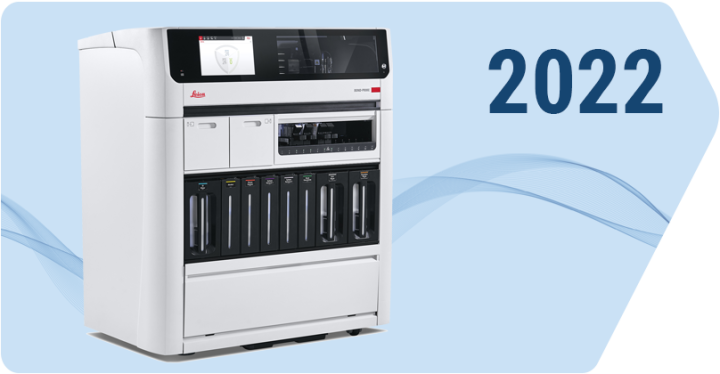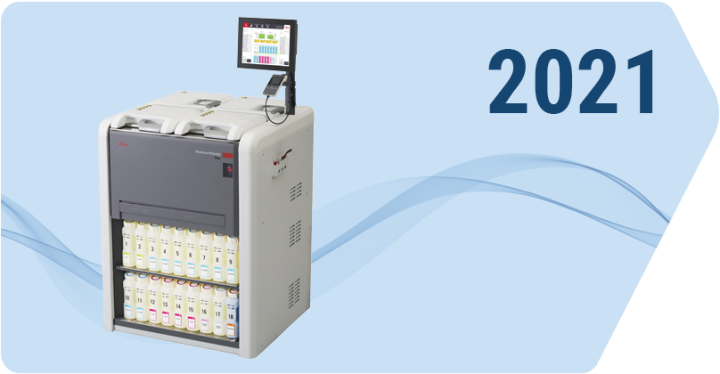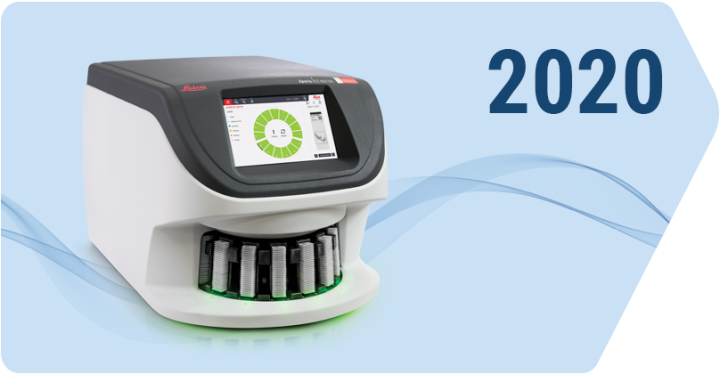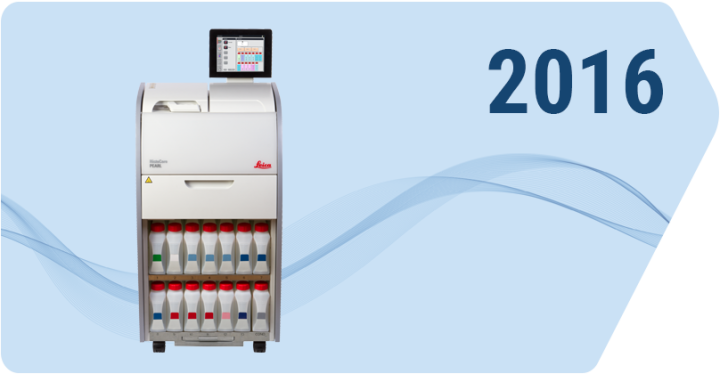
History
|
2012 - Present |
New Era of Science & Technology |
|
2005 - 2011 |
Global Expansion Accelerates |
|
1989 - 2004 |
Structuring for Comprehensive Workflow |
|
1930 - 1988 |
Novel Products Drive Company Growth |
|
1900 - 1930 |
Microtomy Technology Advances Amidst Wartime Realities |
|
1872 - 1899 |
The Creation of the Microtome and the Early Years of R. Jung GMBH |
2012 - PRESENT
A NEW ERA OF SCIENCE & TECHNOLOGY INNOVATION

Introduced BOND‑PRIME, a premium Advanced Staining solution to advance diagnostic productivity in the lab. BOND‑PRIME is the only system that delivers all elements of Universal Access, enabling lab technicians to load any slides in any combination, with any reagent, at any time.

Introduced HistoCore PEGASUS, a fully automatic tissue processor with two processing retorts.
The AI and Machine Learning Strategic Business Unit (SBU) is established. The AI/ML SBU is primarily based out of the Vista, CA facility, with the understanding that artificial intelligence is part of the future of pathology. With the expansion of digital pathology, AI may become an essential part of a pathologist’s toolkit.

Introduced the Aperio GT 450 DX, which holds a CE IVD mark, enabling laboratories in select geographies to scale up digital pathology for high-throughput, routine diagnostics.

Introduced the Aperio GT 450, a next-generation digital pathology scanner, for research use only. From the pathology lab to the IT room, the Aperio GT 450 leverages 30+ patents and is designed to scale up digital pathology operations.
Manufacturing of the microtome blade is moved from Eisfeld to Nussloch, returning manufacturing of this keystone product to the site’s original production hall.
The company organizes into two Business Units: Core Histology and Advanced Staining & Imaging.

The HistoCore SPECTRA CV is introduced. Together with the HistoCore SPECTRA ST the new coverslipper system replaced the ST5020 and CV5030 as an integrated system.
Microtomy offerings are rebranded as BIOCUT, MULTICUT, AUTOCUT and NANOCUT devices under the HistoCore designation.
Leica Biosystems Melbourne wins the High Growth Sector – Medical Technology and Pharmaceuticals Award at the 2018 Victorian Manufacturing Hall of Fame Awards ceremony.

The HistoCore PEARL is introduced to the world market. The HistoCore PEARL is a tissue processor that enables even small laboratories to run fully automated processes.

The name HistoCore is introduced to 2015 highlight the Core Histology portfolio.
The HistoCore Arcadia H & C embedding station is the first product introduced in the HistoCore family of products.
The HistoCore SPECTRA ST is introduced, a new routine staining instrument.

Acquired Devicor, a U.S.‑based company with solutions and systems for performing biopsies in cases of suspected breast cancer. With this acquisition, Leica Biosystems expands capabilities to encompass an important sector of women’s health, adding to its product portfolio the Mammotome System for gentle and safe biopsy removal using vacuum technology

Leica Biosystems organizes into three business units:
- Core Histology with sites in Nussloch (GER), Shanghai (CN), and Richmond (USA)
- Advanced Staining with sites in Melbourne (AUS), Newcastle (UK), Danvers (USA) and Amsterdam (NL)
- Pathology Imaging with sites in Vista (USA), Newcastle (UK) and Dublin (IRL)
Leica Biosystems continues to acquire leading companies and technologies that can expand the product portfolio and global reach.
- Kreatech (Amsterdam, NL), a leader in solutions for in situ‑hybridization, a method for the genetic diagnosis of cancer and other diseases.
- Aotec, a long‑time Brazilian distributor. This acquisition expands Leica Biosystems’ and Microsystems’ presence in Latin America.
- "Jung Feintechnik" joint venture for blade production in Eisfeld is established.

Acquired U.S.‑based Aperio, the market leader in digital pathology. With this acquisition, Leica Biosystems gains fully automated scanning systems necessary for the digitization of glass slides.
2005 - 2011
GLOBAL EXPANSION ACCELERATES

Leica Biosystems is established as a distinct company from Leica Microsystems within the Danaher Group.
Leica Biosystems Nussloch receives the Manufacturing Excellence (MX) Award for customer orientation.

Leica Biosystems Nussloch receives the North American Product Strategy Award for tissue diagnostics from the research and consulting firm Frost & Sullivan.

Acquired U.K.‑based Genetix, a market leader for digital pathology software and mechanical‑optical systems.

Acquired U.S.‑based Coretech, a market 2008 leader for kerosene.
Acquired U.S.‑based Surgipath, a market leader for histological consumables.

Acquired Vision Biosystems, a market leader in pathology workflow. With this acquisition the company expands its product portfolio with a set of novel and well‑received offerings including antibody testing manufacturer (Novocastra, U.K.), a staining instrument (BOND) and an innovative tissue processor (Peloris). As part of this acquisition, Leica Microsystems Nussloch GmbH and Vision Biosystems Melbourne Ltd. merged in 2006 to form the Biosystems Division.

Leica Microsystems is acquired by U.S.‑based Danaher Corporation. Danaher, a science and technology company, will invest in subsequent years to expand and strengthen the Leica Microsystems portfolio.
The Danaher Business System (DBS) is introduced to Leica Microsystems. DBS is a set of processes that enable continuous improvement in the areas of lean manufacturing, growth and leadership. DBS is used to guide, measure, and create options for how the company continuously improves.
1989 - 2004
STRUCTURING FOR COMPREHENSIVE WORKFLOW
During this era, the product portfolio included traditional microtomes and cryostats, as well as dehydrators, embedding systems, stainers, coverslippers and a range of consumables including microtome blades, tissue cassettes, slides, and various reagents. It was therefore possible to equip a pathology laboratory with all the equipment it needed and at the same time purchase a large proportion of the consumables from Leica.

New production hall opens in Nussloch to accommodate the company’s worldwide growth.

Introduced the world’s first integrated stainer‑coverslipper system, consisting of the ST5020 primary stainer and the CV5030 glass coverslipper.
Relaunched the microtome series with the designations RM 2235, RM2245, RM2255 and RM2265.

Introduced the first‑in‑class printers IP S (Sakura Autowrite S) and IP C (Sakura Autowrite C), a key outcome of the 1997 Sakura/Leica partnership.
Introduced the company’s first online shop. With the advent of internet‑based sales, customers now also had “per click” access to purchase consumables from Leica.

Introduced the ASP300, the world’s first histology instrument to feature a touch‑sensitive screen. The new Tissue Processor had been developed as a prototype at Vision Biosystems.
Introduced two new cryostats, extending the range of the market‑leading product. The CM1100 could be powered by a car battery to support mobile pathologists, and the CM1510 was an entry‑level model for frozen sections.

Introduced the disk microtome Leica DSC1. The novel microtome design offered increased safety for the user, improved cutting quality, and a high degree of automation.
Introduced the VT1000S, a microtome with a vibrating blade for research applications for cutting soft tissue, e.g., brain.

Established a joint venture with Eastern Europe‑based Feintechnik Eisfeld to manufacture microtome blades in‑house. Blade production was started on the 8 premises of the Eisfeld company and from the beginning included several versions under the name Leica DB80.

Leica Microsystems is acquired by investment company Schroders Ventures (later renamed Permira).

125th anniversary of Leica Instruments.
Rotary microtomes re‑introduced to the market under the series designation RM21.
The Leica Group organizes into three independent companies: Leica Camera AG in Solms; Leica Geosystems AG in Heerbrugg, Switzerland; and Leica Microsystems in Wetzlar. The Nussloch and Vienna business units now belonged to Leica Microsystems and were eventually managed as “SBU SSP” (Strategic Business Unit Sample and Specimen Preparation) under the name Leica Microsystems Nussloch GmbH.
Partnership established with Japan‑based Sakura Finetek, featuring an agreement to jointly develop the world’s first inkjet printer for tissue cassettes and glass slides to enable barcoding in histology. In parallel, Sakura is granted marketing authority for the RM2025 manual microtome under the name SRM200.

Joint venture established in Shanghai, China with a local partner with the aim to establish local production for the Chinese market. The new company was located in Pudong and the first product manufactured locally was the manual microtome RM2015.

Product designations harmonized. The new nomenclature followed the specifications of the parent company in Wetzlar and was a letter‑number combination that allowed conclusions to be drawn about the field of application and the work sequence in the laboratory.
Swedish company Palmstierna Int. AB in Solna/Stockholm adopted the microtome technology, which led to the creation of the Cryo‑Macromicrotome CM3600.

Partnership established with the Australian Biomedical Company (ABC), a company which developed an automated instrument for new immunological staining methods. The first products resulting from the partnership include the Histostainer IG (later ST5050, le) and the Autostainer XL, mi (later ST5010). The partnership was exclusive and enabled the company to enter the automated laboratory equipment business, which achieved significant growth. The Autostainer XL is the most sold system of its kind worldwide.
Business Units are introduced as a complement to the company’s established Selling Units. From this point on, the company was divided into Business Units and Selling Units, with SUs reporting directly to the parent company Leica Microsystems Wetzlar.

The Nussloch facility assumes production of the Histokinette, li (predecessor of the TP1020, li) from Cambridge Instruments, as well as production of the Knife Sharpener, re (SP9000) and the HI series (water bath and stretching table) from American Optical, including a technology transfer for cryostats.
The Leica Group is formed from the merger of the WILD LEITZ Group with the Cambridge Instruments Company (St. Gallen, Switzerland). The merger creates a new company that is the world leader in microscopes, surveying and photogrammetry systems, and scientific instruments. The name Leica was chosen for the new group because it represented the company’s best‑known brand. The name originated in 1924, when the world’s first 35 mm camera was developed and marketed by the Leitz company (LEItz CAmera).
1930 - 1988
NOVEL PRODUCTS DRIVE COMPANY GROWTH

Initial takeover of the distribution of Wiener (Reichert) products for Germany from Pabisch GmbH.
Purchased part of the portfolio of the company LKB, Sweden, including the Makrocut product line.
The chassis construction of the Frigocut 2800 was transferred from the company Lahntechnik to Nussloch, which subsequently led to the construction of the Cryohalle in order to be able to produce the greatly expanded portfolio on site.

Cambridge Instrument Ltd. (Dortmund) took over R. Jung GmbH, which at that time formed a group of companies with the Viennese company Reichert and American Optical.

Introduced a suite of new product designs at the Analytica trade show in April 1985. Designs included the BIOCUT 2030, AUTOCUT 2040, SUPERCUT 2050; cryostat models FRIGOCUT 2800 N and FRIGOCUT 2800 E; the heavy and large section microtome P0LYCUT M and E; and POLYCUT MILL and HIST0MAT 3000 automatic plastic embedding machine.

New administration and training building 1984 opens in Nussloch.

The company was transferred to the U.S.‑based Warner‑Lambert Corporation. The companies Reichert (Vienna) and Jung (Nussloch) now supplied their products under the joint trademark “Reichert‑Jung”.
Associates begin to move‑in to the new Nussloch facility.

Company growth results in the Heidelberg facility reaching maximum capacity. A new facility in Nussloch is built which will eventually replace the Heidelberg factory.
Invention and delivery of a betting slip stamp and control device. Against great competition, R. Jung won the tender of the Staatliche Lotto‑ und Totogesellschaft in Stuttgart and then supplied 2,000 devices for installation at the Toto acceptance points in Baden‑Württemberg.

Introduction of new microtome models including the Model 1205 freezing microtome, invented by Gerhard Mößner, and, from the same inventor, the new Model 1120 serial section microtome, which replaced the old Minot microtome. This was later followed by the Model 1130, many thousands of which were shipped all over the world.
During the 2nd World War, measuring circuits were manufactured for installation in anti‑aircraft guns.
After the end of the 2nd World War, the budgets of universities and hospitals were modest, with little to no funds to support the purchase of new equipment. The company diversified its product lines in response, e.g., quick‑change punching dies and quick‑change cutting bushes, the manufacture of which was transferred to R. Jung from the SUSTAN standard program of the Hans Fickert company (Frankfurt/Main). Companies such as Daimler‑Benz AG, Volkswagenwerk, Ford and Opel used these punching standards for their punching tools in the production of sheet metal parts. Often up to 30,000 pieces of these tools left the automatic special department of the R. Jung company in one month. In the period 1950 - 1968 Gerhard Mößner was active as a representative of the R. Jung company in the German Standards Committee for punching tools

Introduced new microtomy offerings including the electric object cooling FRIGOMAT and the electric knife cooling FRIGOTOM. Both devices were later united in the electric cooling unit FRIGOMOBIL.
Further broadened the production range to include the production of drill bushings (as used in tool making for drilling jigs) and special tools and gauges for the telecommunications industry. The Bundespost (Federal Postal Service), Philips, Holland and Ericsson, Sweden became customers of the company, relationships which sustained over many years.
1900 - 1930
MICROTOMY TECHNOLOGY ADVANCES AMIDST WARTIME REALITIES

Microtomy innovation continues and expands.
- Microtome knives in production include the Thoma I model and the Thoma II model.
- Introduced the rocking microtome, the circular section microtome, the student microtome, the microtome Tetrander, the microtome K, the Minot microtome (a serial sectioning microtome), and the L1, L2 and L3 immersion microtomes (primarily used for brain sections in celloid embedding).
Product portfolio diversified to include spark plugs for heavy truck engines, cinema demonstration apparatus, Tankra gasoline gauges, primarily for installation in the luxury cars of Maybach and Horch, perimeters for measuring the visual field on the eye, rudder performance testers for racing boats, as well as Fish marking forceps to study the migration of fish in streams and rivers.

Published first edition of a Japanese‑language Jung microtome catalog, reflecting the region’s growing interest in Jung’s offerings. Japanese Emperor Hirohito, as a private scholar, had Jung microtomes in his biological laboratory. Exports became more and more extensive, and the number of agencies also grew steadily. For example, the Carl Zeiss company in Tokyo had been the Jung representative for Japan since 1920.

The company registered as R. JUNG Aktiengesellschaft, Fabrik für Präzisionsapparate.

Manufactured small munitions, as required by the government during war years.

The company converted to a limited liability company (GmbH) and retained this status until 1922, when Wilhelm Löw was entered as managing director in the commercial register at the Heidelberg district court.

The company moved to the new building at Hebelstrasse 45 in Heidelberg. For many years, however, the factory was without a connection to the city’s electricity grid. During this time, power was supplied via a stationary Deutz gas engine and via transmissions to the various floors.

Plans began to build a company factory just outside the city of Heidelberg, at the so‑called Baggerloch (“Excavation Hole”). This site was to accommodate the new main train station before World War I, but this was not to be realized until much later (1955).
Rudolf Jung’s brother‑in‑law Wilhelm Löw and Rudolf Jung’s sister Lisa Jung assume management of the company.
Rudolf Jung died on February 5, 1900 after a long illness.
1872 - 1899
THE CREATION OF THE MICROTOME AND THE EARLY YEARS OF R. JUNG GMBH

Jung participates in the world exhibition in 1893 Chicago, Illinois (USA).

Jung moved to a larger office and factory premises at Landhausstraße 12 in Heidelberg.

Jung participates in the industrial 1888 exhibition in Brussels.

Rudolf’s brother‑in‑law Wilhelm Löw joins Jung. Löw was an ingenious inventor who developed many devices and included them in the delivery program and remained loyal to the company for 55 years (1878 — 1933).

The Jung company received several gold and silver medals of honor from the Palatinate Trade Association.

Published catalog markets a comprehensive product range in microtomy, and beyond. For example, the catalog included microscopes made by Leitz, Zeiss and Harnack.

Precision Engineering company R. Jung founded by Rudolf Jung in Heidelberg on October 1, 1872. The company bore his name until 1990. The first business premises were located at Hauptstrasse 15, where an ice cream parlor can be found today.
The young company focused on the production and marketing of the world’s first industrially mass‑produced microtome: the sled microtome. The sled microtome was developed in conjunction with Prof. Dr. Richard Thoma. Together, they realized the vision of a reproducible production of wafer‑thin histological kerosene sections for microscopic examination.

Rudolf Jung was born on February 20, 1845 in Calw/Northern Black Forest. There he entered the service of the Eye Clinic of the University of Heidelberg as an optician and precision mechanic. Though his work he developed a productive collaboration with Heidelberg pathologist Prof. Dr. Richard Thoma which would lead Jung to found a company and introduce first‑in‑class microtomes.
Innovative progress can only be achieved with combined forces and determined steps characterized by mutual trust, respect and commitment.
This creates a strong unit that launches important milestones of cooperation for long‑term success.
The Best Team Wins!
This summary was created with the help of many colleagues. Special thanks go to Gerhard Mößner and Ralf Eckert, with support from Jürgen Bader, Olga Colgan, Davena Fynmore, Stephanie Kiefer, Lauren Meinhardt, Klaus Ziegler.